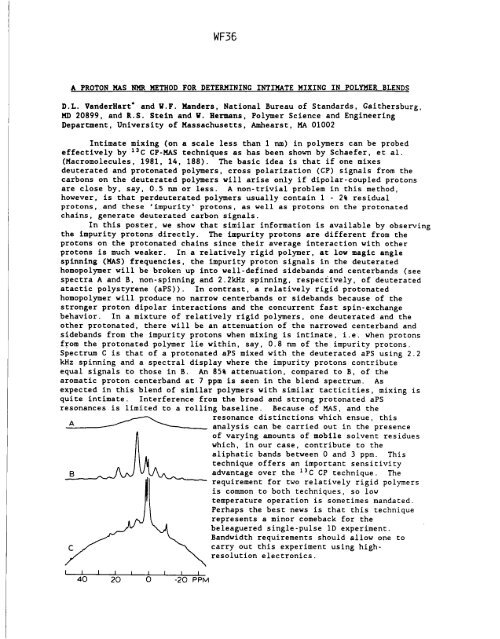th - 1987 - 51st ENC Conference
th - 1987 - 51st ENC Conference
th - 1987 - 51st ENC Conference
Create successful ePaper yourself
Turn your PDF publications into a flip-book with our unique Google optimized e-Paper software.
WF36<br />
A PROTON MAS NMR METHOD FOR DETERMINING INTIMATE MIXING IN POLYMER BLENDS<br />
D.L. VanderHart" and W.F. Manders, National Bureau of Standards, Gai<strong>th</strong>ersburg,<br />
MD 20899, and R.S. Stein and W. Hermans, Polymer Science and Engineering<br />
Department, University of Massachusetts, Amhearst, MA 01002<br />
Intimate mixing (on a scale less <strong>th</strong>an i nm) in polymers can be probed<br />
effectively by laC CP-MAS techniques as has been shown by Schaefer, et al.<br />
(Macromolecules, 1981, 14, 188). The basic idea is <strong>th</strong>at if one mixes<br />
deuterated and protonated polymers, cross polarization (CP) signals from <strong>th</strong>e<br />
carbons on <strong>th</strong>e deuterated polymers will arise only if dipolar-coupled protons<br />
are close by, say, 0.5 nm or less. A non-trivial problem in <strong>th</strong>is me<strong>th</strong>od,<br />
however, is <strong>th</strong>at perdeuterated polymers usually contain 1 - 2% residual<br />
protons, and <strong>th</strong>ese 'Impurity' protons, as well as protons on <strong>th</strong>e prononated<br />
chains, generate deuterated carbon signals.<br />
In <strong>th</strong>is poster, we show <strong>th</strong>at similar information is available by observing<br />
<strong>th</strong>e impurity protons directly. The impurity protons are different from <strong>th</strong>e<br />
protons on <strong>th</strong>e protonated chains since <strong>th</strong>eir average interaction wi<strong>th</strong> o<strong>th</strong>er<br />
protons is much weaker. In a relatively rigid polymer, at low magic angle<br />
spinning (](AS) frequencies, <strong>th</strong>e impurity proton signals in <strong>th</strong>e deuterated<br />
homopolymer will be broken up into well-defined sidebands and centerbands (see<br />
spectra A and B, non-spinning and 2.2kHz spinning, respectively, of deuterated<br />
atactic polystyrene (aPS)). In contrast, a relatively rigid protonated<br />
homopolymer will produce no narrow centerbands or sidebands because of <strong>th</strong>e<br />
stronger proton dipolar interactions and <strong>th</strong>e concurrent fast spin-exchange<br />
behavior. In a mixture of relatively rigid polymers, one deuterated and <strong>th</strong>e<br />
o<strong>th</strong>er protonated, <strong>th</strong>ere will be an attenuation of <strong>th</strong>e narrowed centerband and<br />
sidebands from <strong>th</strong>e impurity protons when mixing is intimate, i.e. when protons<br />
from <strong>th</strong>e protonated polymer lie wi<strong>th</strong>in, say, 0.8 nm of <strong>th</strong>e impurity protons.<br />
Spectrum C is <strong>th</strong>at of a protonated aPS mixed wi<strong>th</strong> <strong>th</strong>e deuterated aPS using 2.2<br />
kHz spinning and a spectral display where <strong>th</strong>e impurity protons contribute<br />
equal signals to <strong>th</strong>ose in B. An 85% attenuation, compared to B, of <strong>th</strong>e<br />
aromatic proton centerband at 7 ppm is seen in <strong>th</strong>e blend spectrum. As<br />
expected in <strong>th</strong>is blend of similar polymers wi<strong>th</strong> similar tacticities, mixing is<br />
quite intimate. Interference from <strong>th</strong>e broad and strong protonated aPS<br />
resonances is limited to a rolling baseline. Because of M.AS, and <strong>th</strong>e<br />
resonance distinctions which ensue, <strong>th</strong>is<br />
A analysis can be carried out in <strong>th</strong>e presence<br />
of varying amounts of mobile solvent residues<br />
which, in our case, contribute to <strong>th</strong>e<br />
aliphatic bands between 0 and 3 ppm. This<br />
technique offers an important sensitivity<br />
advantage over <strong>th</strong>e 13C CP technique. The<br />
requirement for two relatively rigid polymers<br />
is common to bo<strong>th</strong> techniques, so low<br />
temperature operation is sometimes mandated.<br />
Perhaps <strong>th</strong>e best news is <strong>th</strong>at <strong>th</strong>is technique<br />
represents a minor comeback for <strong>th</strong>e<br />
beleaguered single-pulse ID experiment.<br />
Bandwid<strong>th</strong> requirements should allow one to<br />
carry out <strong>th</strong>is experiment using high-<br />
resolution electronics.<br />
I I I I I I I l I<br />
40 20 0 -20 PPM













